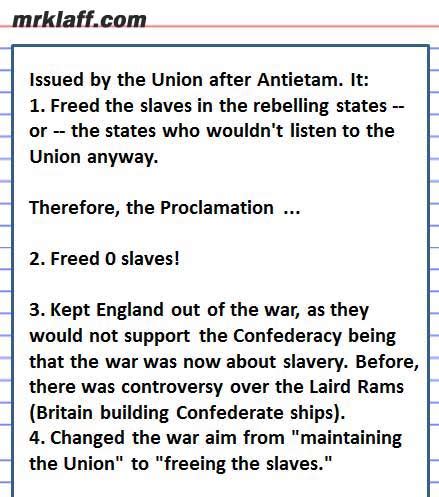Understanding the Emancipation Proclamation
The Emancipation Proclamation, issued on January 1, 1863, by President Abraham Lincoln, was a pivotal turning point in American history. Here’s a detailed definition:

- Definition: The Emancipation Proclamation was an executive order that declared all slaves within Confederate-held territory to be free.
Historical Context
The Emancipation Proclamation was issued during the American Civil War (1861-1865). The Union and the Confederacy, two opposing factions, clashed over the issue of slavery.
- The Union, led by Abraham Lincoln, sought to preserve the Union and abolish slavery.
- The Confederacy, composed of 11 southern states, fought for the right to maintain slavery.
Content and Scope
-
Primary Objective: The primary goal of the Emancipation Proclamation was to weaken the Confederacy by depriving it of its economic and military base, which was heavily dependent on slave labor.
-
Legal Basis: Lincoln justified the Proclamation under his war powers as Commander-in-Chief. He argued that military necessity justified the freeing of slaves to suppress an insurrection.
-
Geographic Scope: The Proclamation applied to all areas of the Confederacy that were not under Union control as of January 1, 1863. It did not apply to slaves in border states or territories already under Union control.
Implementation and Impact
-
Immediate Effect: The Proclamation had little immediate impact on slavery in the Confederacy, as it relied on Union military victories for enforcement.
-
Psychological Impact: However, it had a profound psychological impact, signaling a shift in Union policy and boosting the morale of abolitionists and enslaved people.
-
Political Impact: The Proclamation helped to rally and galvanize Northern support for the war effort and contributed to the Confederacy’s eventual defeat.
Historical Significance
The Emancipation Proclamation was a landmark event in American history with lasting consequences:
-
Abolition of Slavery: The Proclamation marked the beginning of the end of slavery in the United States. It paved the way for the passage of the 13th Amendment in 1865, which abolished slavery nationwide.
-
Political Realignment: The Proclamation deepened the divide between the North and the South, contributing to the sectional tensions that culminated in the Civil War.
-
Symbol of Freedom: The Emancipation Proclamation became a symbol of freedom and equality for African Americans and has inspired generations of activists and civil rights leaders.
APUSH Examination
The Emancipation Proclamation is a crucial topic for the AP United States History (APUSH) exam. Students should be familiar with its content, context, and historical significance.
Table 1: Key Provisions of the Emancipation Proclamation
| Provision | Description |
|---|---|
| Legal Basis | War powers as Commander-in-Chief |
| Geographic Scope | Confederate-held territory not under Union control |
| Exclusions | Border states and Union-controlled territories |
| Enforcement | Relied on Union military victories |
Table 2: Historical Consequences of the Emancipation Proclamation
| Consequence | Impact |
|---|---|
| Abolition of Slavery | Began the end of slavery in the United States |
| Political Realignment | Deepened sectional tensions |
| Symbol of Freedom | Inspired activists and civil rights leaders |
Table 3: APUSH Exam Focus on the Emancipation Proclamation
| Exam Area | Expected Content |
|---|---|
| Context | Historical background, political divisions, and Union strategy |
| Content | Provisions, geographic scope, and exclusions |
| Impact | Psychological, political, and historical significance |
| Analysis | Interpretations and controversies surrounding the Proclamation |
Table 4: Strategies for Studying the Emancipation Proclamation
| Strategy | Description |
|---|---|
| Read Primary Sources | Examine the text of the Proclamation and相关的文件 |
| Analyze Context | Understand the historical events and political climate that led to the Proclamation |
| Consider Impact | Evaluate the immediate and long-term effects of the Proclamation |
| Practice Exam Questions | Take practice tests and review past exam questions to prepare for the APUSH exam |
